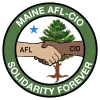Pre-Apprentices Fix Up Union Hall & Learn From Elder Union Members About the 1987-88 Jay Strike
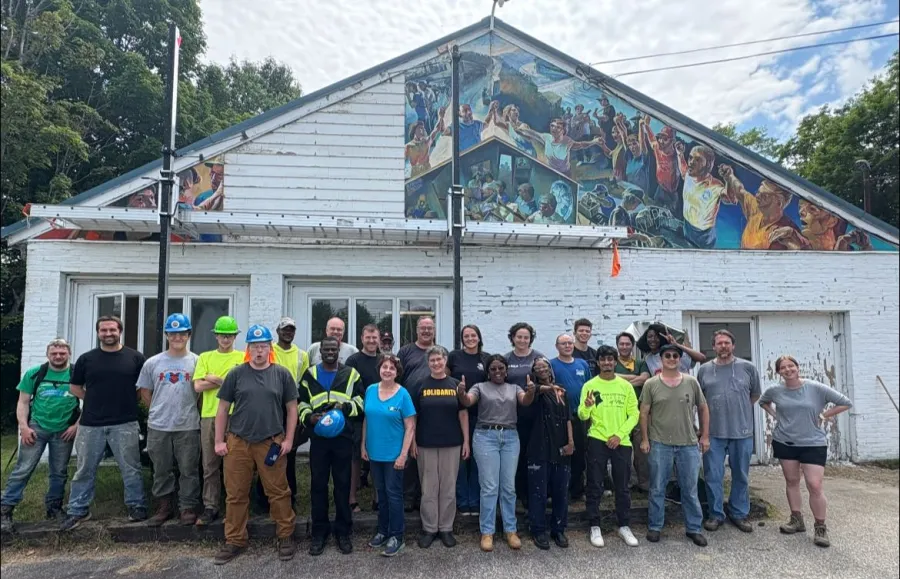
PHOTO: Pre-apprentices, Jay strikers & staff from the Maine AFL-CIO & Scontras Center at the Local 14 Solidarity Center on July 1.
On July 1, a diverse cohort of pre-apprentices from the Union Construction of Maine gathered at the Local 14 Solidarity Center in Jay for a day of work and learning. The workers — which included young Mainers just out of high school, working parents and immigrants from five different nations — were joined by a group of retired paper mill workers who participated in the 16-month International Paper Strike of 1987-88. The pre-apprentices worked in teams to paint the inside of the hall, landscape around the building and install new front steps. Lunch was followed by presentations about the strike from the people who were there.
Jay striker and Western Maine Labor Council President Linda Deane gave a presentation about the strike. During the 1980s, IP and other companies across Maine and the nation took their cue from President Ronald Reagan’s firing of striking air traffic controllers and saw it as an opportunity to break unions.
Jay workers were among paper workers from IP mills in five other states who rejected the company’s demands for huge concessions. On June 16, 1987, 1250 workers at the IP mill in Jay walked out of the plant and went on strike. The strike lasted for 16 months, with only 78 workers breaking ranks to cross the picket line before the International union ended the strike on October 11, 1988.
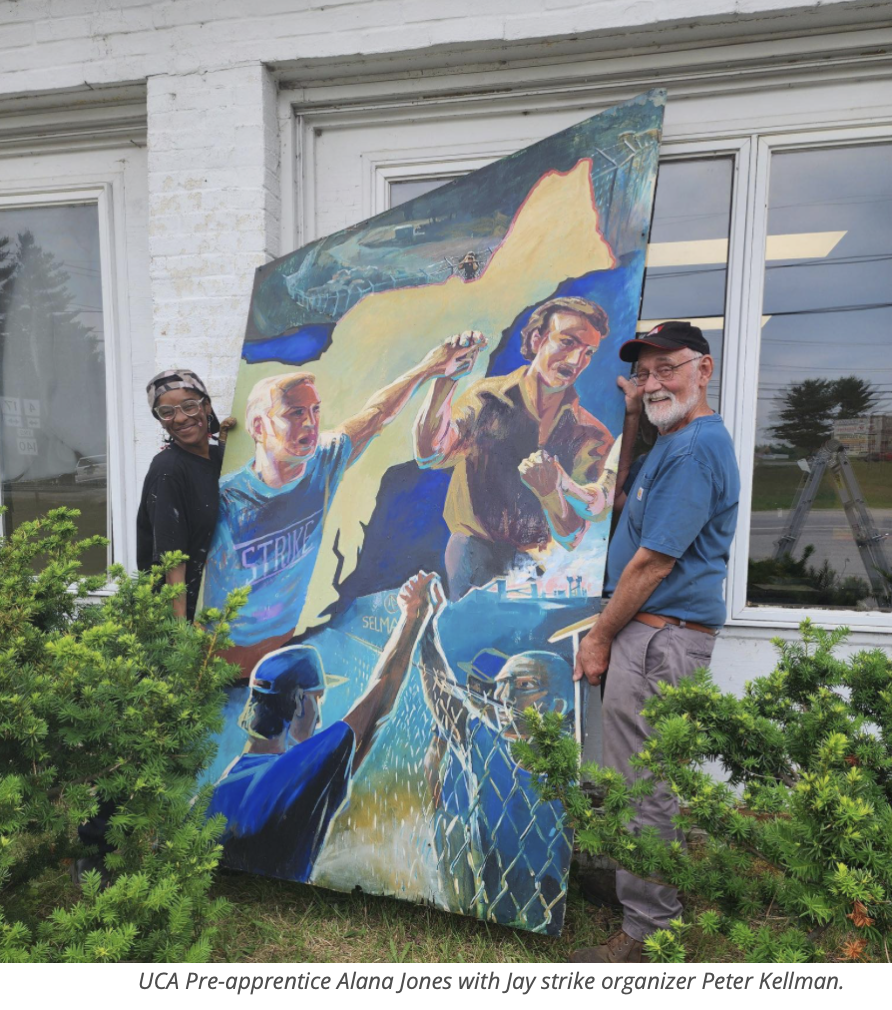
Artist Andrea Kantrowitz was so moved by the solidarity, unity, and shared sacrifice of the strikers that she painted the iconic Jay Strike Mural on the front of the union hall depicting key events of the strike. The mural features images of the strikers, some of whom were at the hall on July 1, holding raised hands in a show of solidarity and the mass meetings that filled the local high school gym to capacity every Wednesday for 16 months. It shows the workers singing songs like “Solidarity Forever” as the Local 14 band the Union Picketers played rousing labor songs at the mass meetings. The band even wrote some originals like “The Union Buster,” “BE&K’s (BEAKES)” and “Union Tiger.”
The mural depicts workers on the picket line shouting at the scabs. In one of its most moving scenes, the Jay strikers and workers at the IP mill in Pine Bluff, Arkansas are depicted shaking hands over the security fence after union leaders at the mill rebuffed the Maine delegation’s request for support. A campaign sign for Democratic presidential candidate Jesse Jackson in the mural signifies strong support the civil rights leader received when he came to Jay to show his solidarity with the strikers. In October, 1987, 3500 people crammed into the Jay Community Center to hear Jackson and had to raise their hands above their heads just to applaud. The atmosphere was electric as the crowd sang union songs and chanted “Scabs Out! Union In!”
Jackson began his speech with a story about his trip to Cudahy, Wisconsin to support workers who had been locked out. They told him, “But you must understand, uh, we’re white. In Cudahy, Wisconsin?’ I understand. I'm still coming.” Jackson continued,
“They said, ‘but you really don't understand. Scabs are crossing our picket line.’ I said, 'I'm coming.’ ‘But you really don't understand. They brought the scabs down from Milwaukee, you see, and the scabs are black.’ (Laughter) I said, ‘but I'm still coming.’ (Cheers) I said, ‘I'm gonna meet with the scabs on the inside and the workers on the outside, because it's painful to me to see workers divided. I have a sense of profound pain for those trapped in poverty who lose their self-respect….’
“You do not determine scabs by race or sex, you determine scabs by function. (Cheers) The scab on your arm, what is its function? It does not matter the color of the scab, it functions to cover up pus and cancer. (Cheers) The function of a scab is to drive down wages. The function is to break union solidarity. A worker has a moral foundation. The Bible says a servant is worthy of his or her hire. A servant is worthy of getting paid for work. That's a moral foundation. The scab has no moral foundation. (Wild cheers) What the scabs must understand is about the weakness of scabbism. You take somebody's $10 an hour job for $8, there's a $6 crowd waiting for you!” (Cheers)
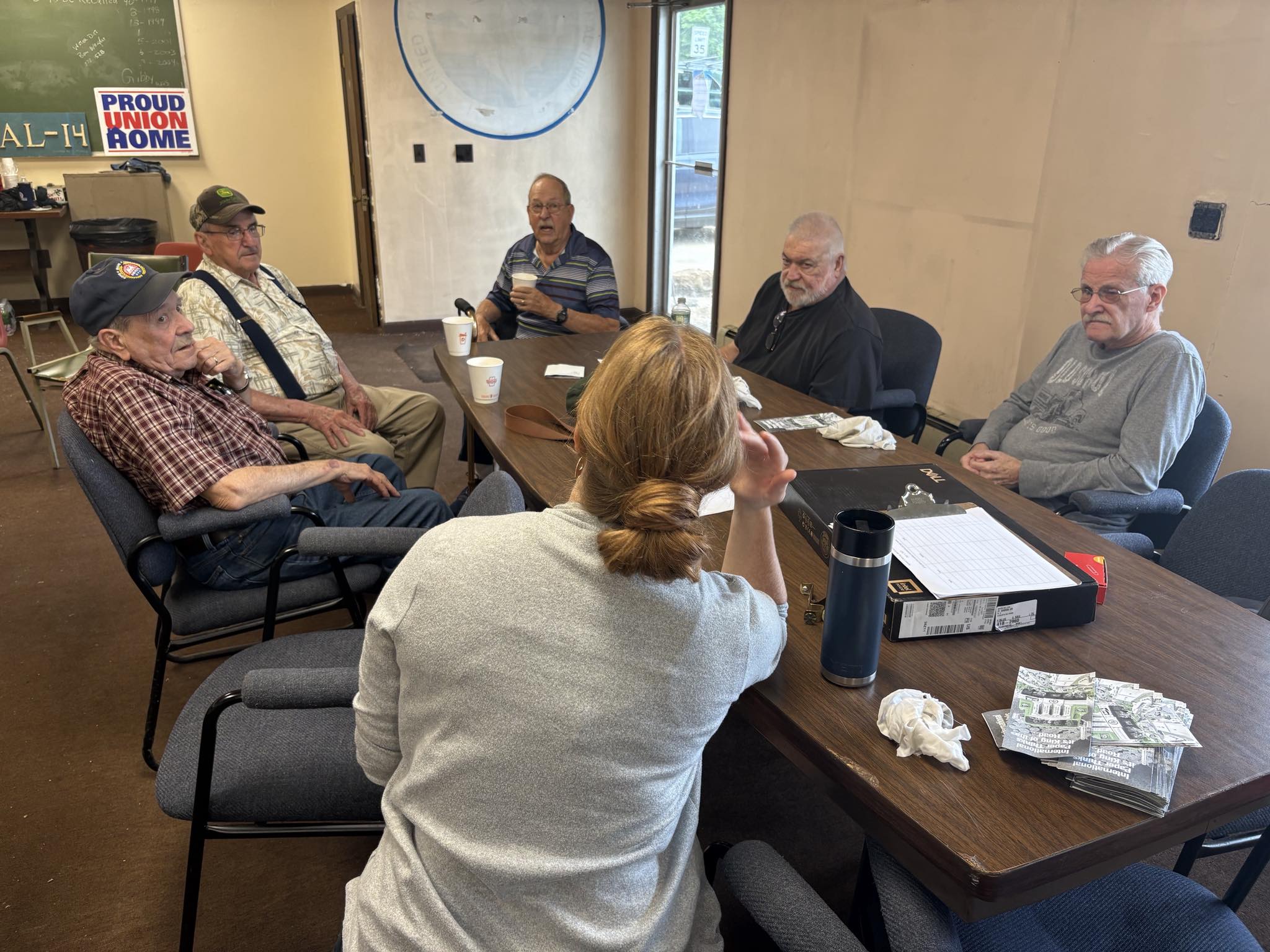
Local 14 retirees at the Solidarity Center on July 1.
As author Julius Getman wrote in his book about the strike, The Betrayal of Local 14, Jackson linked the workers' struggle to those of dairy farmers and meat cutters in the Midwest, civil rights workers in the South and anti-Apartheid struggles in South Africa. He compared the Jay strikers to the children of Israel facing the Red Sea and urged them, “Do not give in.” The workers cheered and stomped their feet, chanted, ''Reagan out, Jesse in,'' and swayed to and fro to the refrain of ''We Shall Overcome.’' Jackson stood in the center with his arms around the children of strikers. Getman noted that Jackson’s appearance changed many of the workers’ political views.
"I was never a Jesse Jackson fan at all, but after he gave that speech I was converted,” said United Paperworkers' International Union (UPIU) Local 14 President Bill Meserve. “If he believes in what he says and he says what he believes, I agree with him 100 percent."
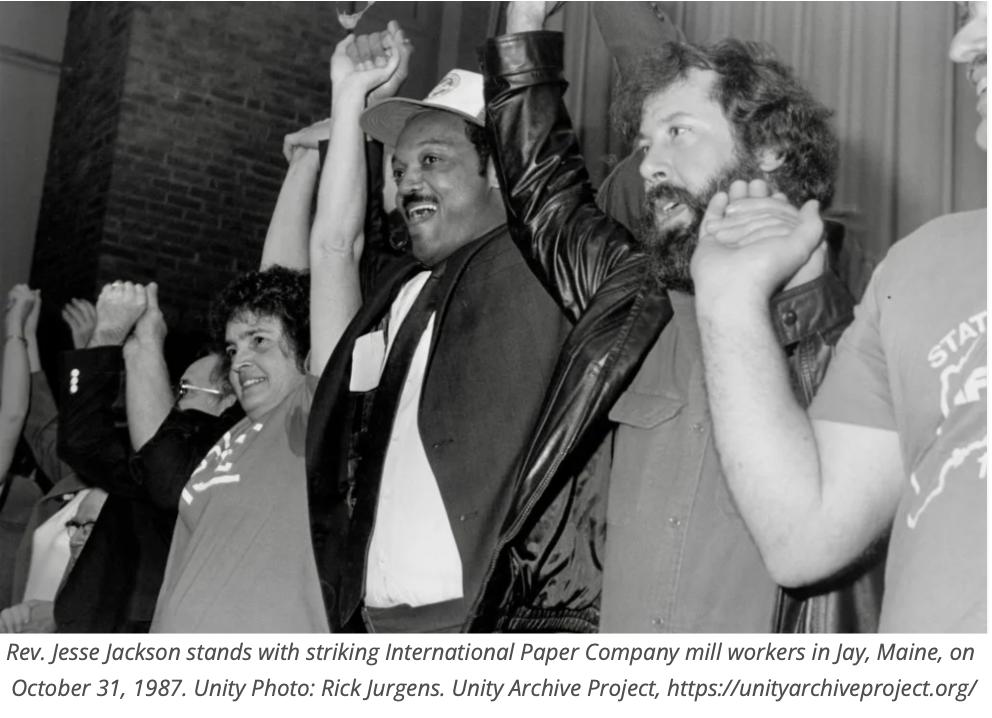
A woman striker told strike organizer Peter Kellman, "Yesterday I wouldn't think of voting for a Black man for president. Tonight I gave him a check for his campaign." With the support of Maine labor, Jackson finished a strong second at the Democratic caucuses in the overwhelmingly white state. Meserve became a Jackson delegate at the 1988 Democratic Convention. The experience of the strike inspired multiple Jay strikers to run for political office, winning seats on the Jay Select Board and being elected to the Maine Legislature.
On October 10 1988 the national UPIU abruptly announced an end to the strikes at IP mills in Jay, Wisconsin and Pennsylvania. IP fired the Jay strikers and permanently replaced them with scabs. But the workers continued to use the Local 14 union hall as a gathering place and information clearing house for labor struggles and union job openings across Maine. Many of the strikers were not hired back to the mill until ten or fifteen years later.
For many years, several Local 14 members paid dues to keep up the union hall and gathered there frequently for coffee and to play cards. As regulars at the hall gradually passed away, empty chairs along the wall with their names replaced the departed brothers and sisters. These days, the elderly Local 14 members sip coffee and talk every Tuesday morning, but they are often joined by younger union members to fix up the hall and hear their wisdom about their heroic struggle nearly 40 years ago. In 2023, the Local 14 retirees sold the building to the Western Maine Labor Council for $1 to turn it into a center for labor history, learning and action.
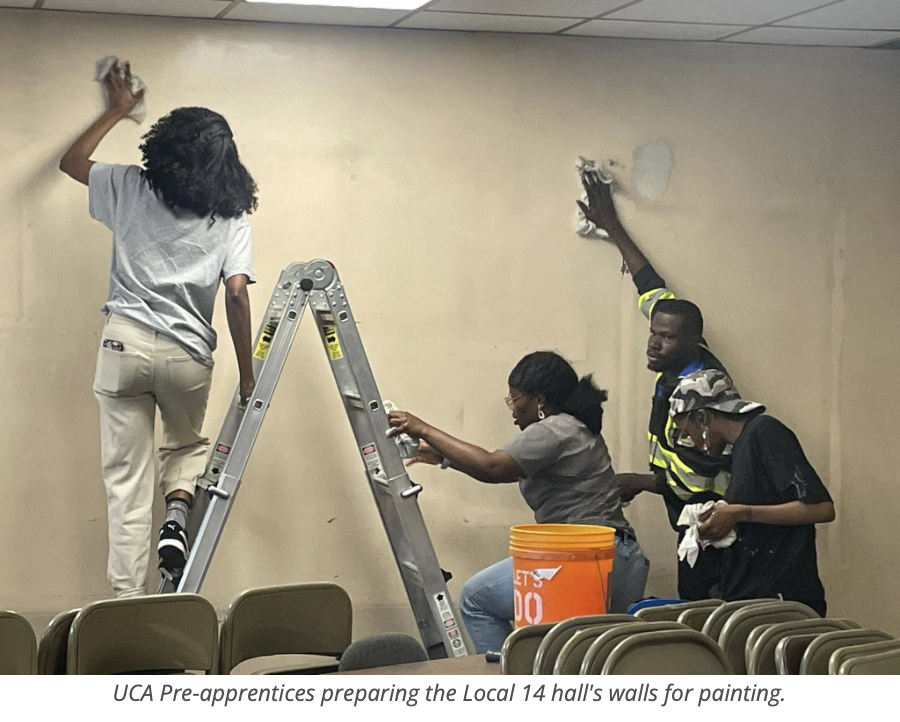
Pre-apprentices at the July 1 event asked strike organizer Peter Kellman about how he dealt with bitterness at the workers who crossed the picket line. On one level he said he will never forgive them for taking someone else’s job, but on an intellectual level he understands how it's the company that divided the community and pit workers against each other. He said during the Jay strike he heard stories from elderly residents about their lingering resentment toward men still living who had scabbed during the IP Strike of 1921.
But after some research, he discovered that some of the strongest strikers in the 1987-88 strike were the children of the scabs of 1921. He noted that immigrants have historically been used as scabs to break strikes and undermine workers’ wages. But in some cases like the 1912 “Bread and Roses” textile strike in Lawrence, Massachusetts, immigrants from diverse nationalities have united together to defeat the company.
Attendee and CWA 1400 member Tracy Urquhart shared a story about the often tense relationships between scabs and Local 14 strikers who were hired back after the strike ended. One day, both scabs and strikers were working on the same paper machine on the Friday before the 4th of July, which fell on a Sunday that year.
“One of the scabs starts saying, 'You know, what the hell, we're gonna be working on Sunday? I’m gonna be working on the 4th of July. And we're not gonna be getting paid overtime. Like, are you kidding me?'" she said. “And of course the strikers who had gone back in said, 'What the f—— do you think we were out there for?'"
The conversations and stories the Jay strike veterans shared stirred emotion in the room. Pre-apprentice Alana Jones was moved to tears by their solidarity.
“Something about it just really, it hit me hard,” she said, getting choked up. “And like the fact that you guys worked so hard together and went through so much and you still have this same solidarity. I want to be able to help with that kind of thing.”
Autumn Riley of Peru said she drove by the union hall every day on the way to work and the mural always caught her eye, but she never knew about its significance.
“I think what you guys do is pretty cool,” she said. “You're keeping a piece of history here. I've learned a lot that I never would've heard ever in my life."
Pre-apprentice Katherine Rigney, 27, said she had become burned out on politics after being active in political movements since she was a teenager, but that the presentations gave her some perspective.
“ I have only ever seen the world get worse and worse as long as I've been alive,” she said. “And I think it's always helpful to talk to people who have been in the work longer than me.”
Q Lo of Lewiston said the stories strengthened his own understanding of his family history in the labor movement. The son of Chinese immigrants from Hong Kong, he recalled marching with his mother in a strike in New York City when she and her coworkers were forming a local of the International Ladies Garment Workers Union.
“I just thought we were having parades, marching, and, you know, we shut down traffic,” he said. “I think it only took that one march for them to concede something because then they went back to work fairly soon after that march.”
Fernanda Pambo of Portland, who is originally from Angola, said she had been struggling with culture shock after coming to the US. Her father had told her not just to learn the language in America, but also learn the culture because it gives you a deeper understanding of the people. She said the experience at Local 14 hall was very meaningful because it helped her better understand the culture of the labor movement.
Jay striker and former State Rep. Randy Berry expressed gratitude to the pre-apprentices for coming in to help fix up the hall.
“They had great attitudes and they worked hard this morning. I appreciate the opportunity to talk about union fellowship and solidarity,” he said. “Hopefully they can find a career, raise healthy families with good wages and benefits like health insurance and pensions to live the American Dream.”
Former USW member and labor organizer Rod Hiltz said the seeing the union hall being fixed up brought back a lot of memories. In 1987, he worked at the Somerset Mill in Skowhegan and his father and two cousins were strikers in Jay.
"It took me decades after the strike to be able to drive through Jay without my body tensing up with rage," he recalled. "I remember how Local 14 was a buzz of activity during the strike, then for years as I drove by the union hall it was empty. I'd always stop anyway, still do. I'd try to look in the windows. I'd always look up at that mural and remember. Remember the morality of so many standing up against Goliath. Remember the strength of real people taking a stand for what is right.
"To some passersby that mural means nothing," he added, "but to some that mural means everything. That strike defined lives, families, the whole community. This country, this world, is so messed up right now. Seeing all these great volunteers preserve something that means so much to so many is an island of goodness in a sea of hatred. What you all are doing at Local 14 matters. Thank you all."
As Jones was leaving the Solidarity Center that afternoon, she called the whole experience “eye opening.”
“It’s changing everything about the way I initially approached life,” she said. “I initially thought I just needed to get a job and then do the long march, but I've realized with this opportunity that I can actually have a career that I genuinely care about. I've been working for over 10 years and I've never felt this way before.”
On Thursday, the UCA apprentices graduated in a moving ceremony in Lewiston. We wish them the best of luck as they pursue careers in the trades and hope they will stay active in the labor movement!
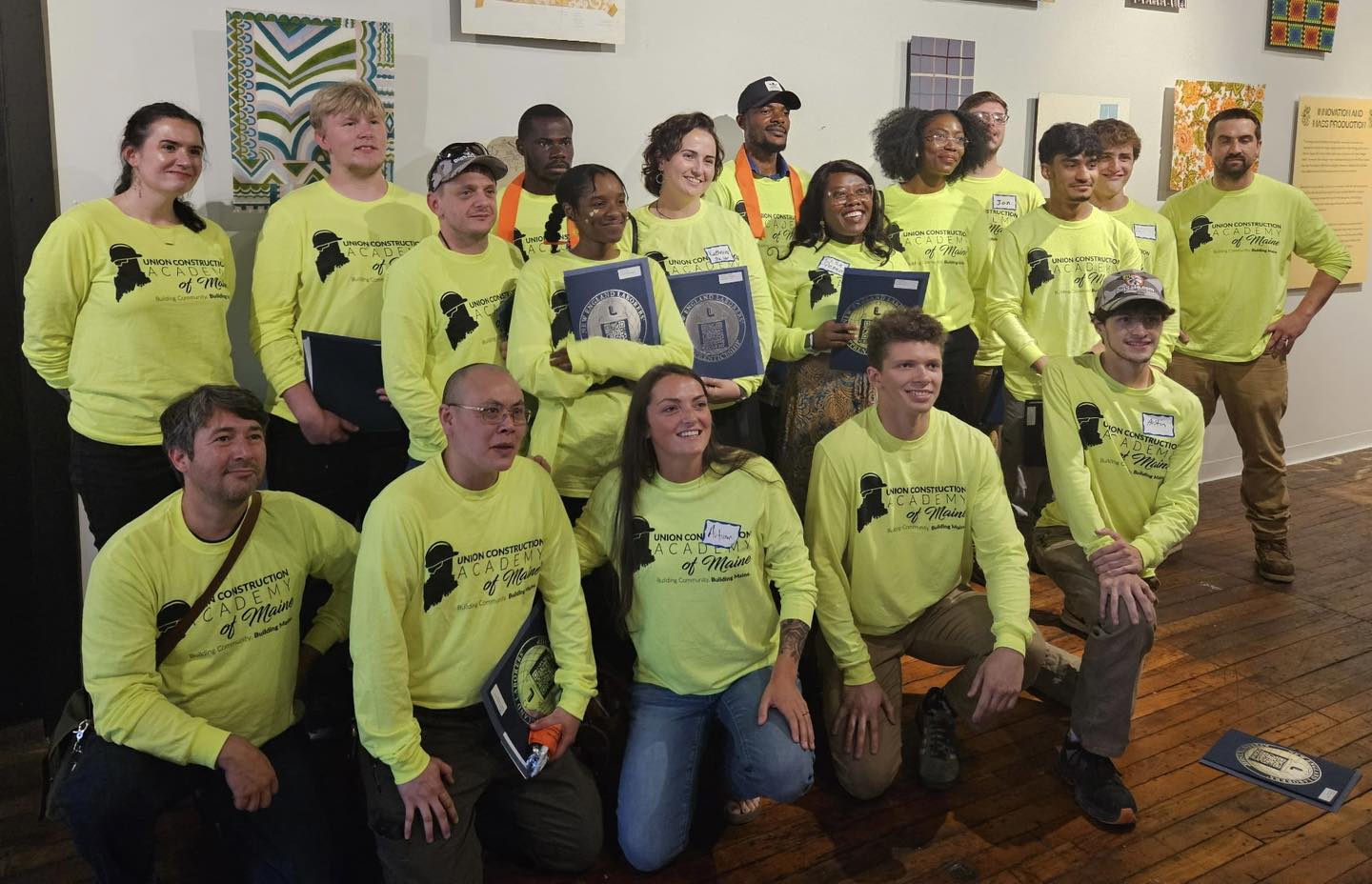
UCA pre-apprentices at their graduation on Thursday.
